-

人教版高中英语必修2Wildlife Protection说课稿3篇
When it comes to the students’ studying methods, I'd like to introduce my Ss first. The Ss have a good command of basic language points. They’re interested in learning English, and they take an active part in English class, so they will have fun in autonomous, cooperative and inquiry learning. I will just serve as a guide, showing them the way to explore how to make more progress in their English learning.Now it’s time for the most important stage of this lesson. My teaching procedures are arranged as follows:Step1.Leading-in (3 minute)Play a video of a wide variety of wildlife to introduce my topic. Step2. Speaking (12 minutes)We will use our textbook Page25. Let the Ss fast read the short paragraph to warm up. Ask them to talk about the report on some endangered wildlife in China with the dialogue patterns on the screen. Lastly, I will invite some groups to demonstrate their dialogues about saving wildlife in China.Step3.English play (3 minutes)Watch another video in praise of their excellent performance just now. It’s about Jack Chen’s(成龙)and Yang Ziqiong’s wildlife protection.Step4. Listening (twice 13 minutes)This time, I’ll ask the Ss to fill in the blanks of the monologue of the 2 movie stars above. Step5.Discussion (3 minutes)Which would you like to choose to wear, clothes made of cotton, artificial leather or animal skins? Why ?Step6. Summary (3 minutes)1. If there were no wildlife, there wouldn’t exist human beings. If the buying stops, the killing can, too.2. Animals are our friends. To love animals is to love ourselves. Stop hunting, killing and destroying wildlife.3. Let’s live in harmony with all the living things in the world. Step7. Music appreciation (3 minutes)Let the Ss appreciate the song Earth Song by Michael Jackson. Last but not the least, I will show you my blackboard design.

人教版高中英语必修4Women of achievement说课稿4篇
Good morning, distinguished judges:It’s my honor to talk about my teaching ideas with you. Today my topic is Women of Achievement. My presentation consists of six parts: the analysis of teaching material and student, teaching aims, key and difficult points, teaching and studying method, teaching procedures and blackboard design.First, let’s focus on the analysis of teaching material. This lesson is from New Senior English for China Student’s Book 4 Unit 1, the reading part. The main topic of the passage is the introduction of a student of Africanwildlife. After this lesson, the students will learn more information about her studying chimps in Africa, and their reading and speaking abilities can be developed as well.The next part is the analysis of students. My students are in senior high students. They have learnt English for many years, they’ve known many words and sentences, but their speaking and reading abilities are still not very good. So I will practice their speaking and reading abilities through different exercises.According to the New Standard Curriculum and the present situation, I set the teaching aims as follows: firstly, knowledge aims. Students can grasp some new words, such as worthwhile, move off. Moreover, students can understand the content of the passage and get familiar with the topic of studying chimps in wildlife. Secondly, ability aims. Students can use reading strategies such as skimming and scanning in reading process. Thirdly, emotional aims. Students can have the awareness of protecting animals and care about animals.Based on the above analysis, the key point of this lesson is to get the main idea and the detailed information from the passage; the difficult point is to talk about the wildlife protection and use reading strategies.

人教版高中英语必修3Healthy Eating说课稿4篇
Language learning needs a context, which can help the learners to understand the language and then can product comprehensible output, so computer has the advantages to make the materials attractive.Part 3 Learning MethodsTask-based, self-dependent and cooperative learningPart 4 Teaching ProcedureStep One Lead-in“Interest is the best teacher.” Therefore, at the very beginning of the class, I should spark the students’ mind to focus on the centre topic “the band”. I’ll show some pictures of food to attract their attention and then bring some questions.Question:What kind of food they like?What should go into a good meal?The answers must relate to the diet. After this, the students will be eager to know something about a balance diet and this is the very time to naturally lead the class into Step 2Step 2 Reading for information: skimming and scanning In this step, I use Task-based Language Teaching method, which can give students a clear and specific purpose while skimming and scanning the context.Task 1 General ideaThe students will be asked to just glance at the title and the pictures of the passage, and then guess what they will read in the text. And they’ll be divided into groups of four to have a discussion.The purpose is to inspire the students to read actively, not passively. In addition, the task is to develop the students’ reading skill by making prediction and to encourage the students to express their thoughts in English and cooperate with each other.Task 2 Main idea of each paragraphCooperative learning can raise the students’ interest and create an atmosphere of achievement. Based on this theory, I divide the whole class into 4 groups to skim the whole text and get the main idea of each paragraph.

人教版高中英语必修5First aid说课稿6篇
In this class, I have 3 teaching aims, that is, knowledge aims, ability aims and emotion aims.1) Knowledge-Teach students new words and expressions, such as temporary, bleed,sprain choke, first aid, fall ill and so on.-Enable students to have a better understanding for some basic knowledge of first aid.2) Ability-Train students’ speaking, reading and writing abilities by different teaching activities, such as skimming, comprehending, team work, role play, retelling and writing.-Develop students’ reading strategy on how to move general idea to specific information.3) Emotion-Promote students’ awareness of giving first aid.- Cultivate students’ creativities.Then let’s come to my teaching methods and activities.III. Teaching methods and activities:To achieve different teaching aims, various kinds of teaching methods and activities will be adopted throughout this period, such as TBL (task-based learning), skimming, team work, brainstorm and others, which can offer students opportunities to fulfill tasks in which they can use language to achieve a specific outcome.IV. Teaching aids:Computer and blackboardV. Teaching important points:1) Make students have a clear mind for the structure of the text.2) Help students understand the theme of the text.VI. Teaching difficulties:1) So many new words may affect students’ understanding.2) How to get students to know about the functions of the skin and thecauses, characteristics and treatments for different degree burns,and the knowledge about giving first aid. VII. Blackboard design:

人教版高中英语必修5Making the news说课稿4篇
今天我们来介绍一下必修五第四单元的授课方式。这个单元的题目是Making the news。应该是学生比较感兴趣的话题,学生往往对新闻工作充满好奇,所以我们可以利用这个机会多设计一些师生互动和学生互动,来激发起学习的积极性,提高学习效率。同时我们可以利用这个单元不仅帮助学生掌握语言知识,培养语言能力,同时让其了解新闻工作的重要性,培养起社会智能感。这个单元分为六个课时,它的教学目标是这样的:语言目标是掌握词汇表中的常用单词和短语,掌握倒装句的一些基本用法。 技能目标是能初步掌握约会的基本句型并在真实的场景下正确运用。新闻报道类文章的写作技能。采访的基本规范和沟通技能。情感目标是对新闻报道的客观性和真实性有更好的理解。对新闻记者的职业有更深入的了解,并能体会其工作的重要性。下面我们来介绍一下第一课时的授课方式,第一课的教学目标是这样的第一课时的教学目标语言目标:单词:Occupation, journalist, editor, photographer, curious, personality, enthusiasm
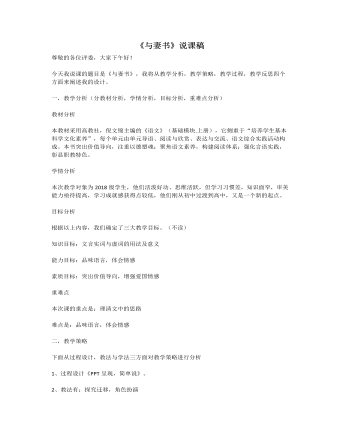
《与妻书》说课稿2020—2021学年统编版高中语文下册
二,教学策略下面从过程设计,教法与学法三方面对教学策略进行分析1、过程设计《PPT呈现,简单说》。2、教法有:探究迁移,角色扮演3、学法有:小组讨论,自主学习,三,教学过程本次课前预习,课中学习,课后练习三个环节。(一)课前准备课前准备环节分前置性学习和课前诊断。前置性学习可通过微课,教材等课程资源,对相关知识进行自学,了解背景,疏通文义,实行小检测。(二)课中学习课中学习环节分自主学习,合作探究,拓展延伸三个步骤。步骤一,自主学习文言实词与虚词的用法及意义,总结规律。步骤二,围绕题目展开,理清文中思路,并品味语言,体悟情感。学生先自由讨论发言,分析品味文中的语言所包含的情感,揣摩人物的心理,说话的语气,然后读出来,大家分享。老师也可以参与,师生共读共赏,最后可以听听名家朗诵音频,进行多向比较鉴赏。
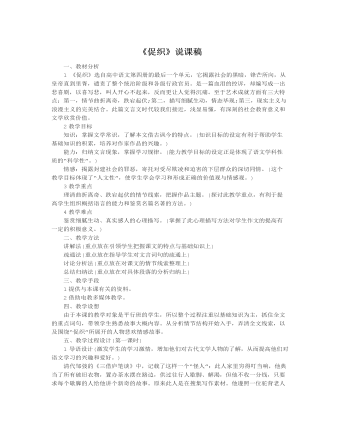
《促织》说课稿2020-2021学年统编版高中语文必修下册
蒲松龄(1640——1715)字留仙,一字剑臣,号柳泉居士。山东淄川(今淄博)人。清代小说家,出身于没落地主家庭。天资聪明,学问深厚,十九岁时连中县、府、道三个第一,但此后屡应省试不第,年七十一,始被补上岁贡生,一生忧郁自伤,穷愁潦倒。从二十岁左右开始写作,历时二十余年,创作了文言短篇小说集《聊斋志异》。另有诗、文集《聊斋诗集》、《聊斋文集》。《聊斋志异》是蒲松龄倾力创作的文言短篇小说集。“聊斋”是作者的书斋名。“志异”就是记述花妖狐鬼及其他一些荒诞不经的奇闻轶事。作者巧妙地通过这些离经虚幻的故事,大胆地揭露社会多方面的黑暗现实,赞美了青年男女敢于冲破封建礼教樊篱的精神,抒发了作者自己满腔的“孤愤”。郭沫若曾题蒲松龄故居联:“写鬼写妖,高人一等;刺贪刺虐,入木三分。”老舍题联:“鬼狐有性格,笑骂成文章。”简明而生动地道出了《聊斋志异》的文学特点。
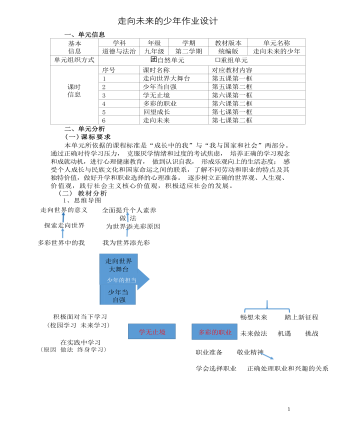
九年级下册道德与法治走向未来的少年作业设计
2、内容内在逻辑本单元是九年级下册最后一个单元,从学生个体生活、家庭生活、学校生 活、社会生活和国家、世界,最终回到青少年自身,既是前两个单元的延续, 也是对九年级乃至初中阶段学习内容的承接和提升。第五课“少年的担当”主要引导学生与时代同步,走向更广阔的世界,在 与外部世界交往中丰富自己的经历、拓宽自己的视野,理解青少年具有国际 视野和情怀的重要意义,明白当代少年的历史责任是时代赋予的,理解青少 年全面提高个人修养的意义;第六课“我的毕业季”中设计了“学无止境”和“多彩的职业”,帮助学 生知道学习生活中出现的各种压力,理解学习的必要性和重要性,能够在实 践中学习,树立终身学习理念,知道不同劳动和职业具有独特价值,理解爱岗 敬业的重要性,,做好自己的职业规划和准备,能够践行社会主义核心价值观。第七课内容基本逻辑是立足当下、回望过去、展望未来。引导学生反思个 人成长的维度和方式,理解个人成长的关键,明白过程和结果的辩证关系,了 解初中生活之后的发展路径与内容,理解学习和实践的关系。激励他们树立 远大志向,做有自信,懂自尊,能自强的中国人成为中华民族的栋梁。
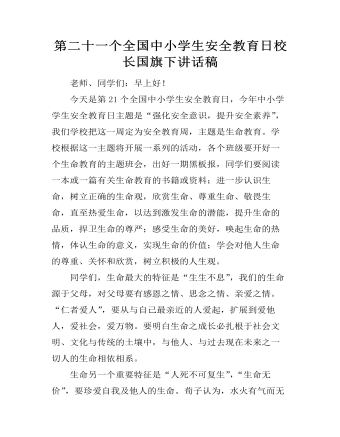
第二十一个全国中小学生安全教育日校长国旗下讲话稿
老师、同学们:早上好!今天是第21个全国中小学生安全教育日,今年中小学学生安全教育日主题是“强化安全意识,提升安全素养”,我们学校把这一周定为安全教育周,主题是生命教育。学校根据这一主题将开展一系列的活动,各个班级要开好一个生命教育的主题班会,出好一期黑板报,同学们要阅读一本或一篇有关生命教育的书籍或资料;进一步认识生命,树立正确的生命观,欣赏生命、尊重生命、敬畏生命,直至热爱生命,以达到激发生命的潜能,提升生命的品质,捍卫生命的尊严;感受生命的美好,唤起生命的热情,体认生命的意义,实现生命的价值;学会对他人生命的尊重、关怀和欣赏,树立积极的人生观。同学们,生命最大的特征是“生生不息”,我们的生命源于父母,对父母要有感恩之情、思念之情、亲爱之情。“仁者爱人”,要从与自己最亲近的人爱起,扩展到爱他人,爱社会,爱万物。要明白生命之成长必扎根于社会文明、文化与传统的土壤中,与他人、与过去现在未来之一切人的生命相依相系。

第22个“全国中小学安全教育日”国旗下讲话稿:珍爱生命,安全第一
尊敬的各位老师,亲爱的同学们:大家上午好!三月,是春风和煦、万木吐绿的美好季节,俗话说:“一年之际在于春。”人们把许多纪念日都放在了三月,如:3月5日“学习雷锋”纪念日,3月8日国际劳动妇女节,3月12日植树节,3月15日国际消费者权益日。今天我讲的是大家可能还不太熟悉的一个纪念日:那就是“全国中小学安全宣传教育日”。1996年由国家教委等有关部门规定,每年三月最后的一个星期一被定为“全国中小学安全教育日”。今天是第22个“全国中小学安全教育日”。我今天国旗下讲话的题目是:《珍爱生命,安全第一》。当我们随着一声清脆的啼哭声降落到人间,这就标志着又给人世间增添了一份宝贵的财富。因此我们要懂得在人生的路上走好每一步,处处小心,时时提防,保持警惕的头脑,绷紧安全之弦。事事处处想到“安全”二字。学校高度重视校园安全工作,采取了多种加强校园安全的措施。对同学们多次进行交通安全、运动安全、食品安全、用电用气安全、防火安全等教育,以提高我们的安全意识,提高我们自我保护的能力。但是,还有一些同学视安全隐患而不顾,如课间在走廊里打闹;上下楼梯时互相拥挤
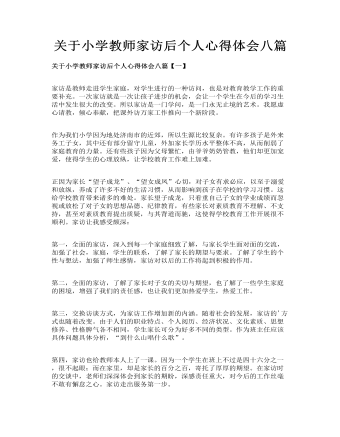
关于小学教师家访后个人心得体会八篇
第一,全面的家访,深入到每一个家庭细致了解,与家长学生面对面的交流,加强了社会,家庭,学生的联系,了解了家长的期望与要求。了解了学生的个性与想法,加强了师生感情,家访对以后的工作将起到积极的作用。 第二,全面的家访,了解了家长对子女的关切与期望,也了解了一些学生家庭的困境,增强了我们的责任感,也让我们更加热爱学生,热爱工作。 第三,交换访谈方式,为家访工作增加新的内涵。随着社会的发展,家访的'方式也随着改变。由于人们的职业特点、个人阅历、经济状况、文化素质、思想修养、性格脾气各不相同,学生家长可分为好多不同的类型。作为班主任应该具体问题具体分析,“到什么山唱什么歌”。
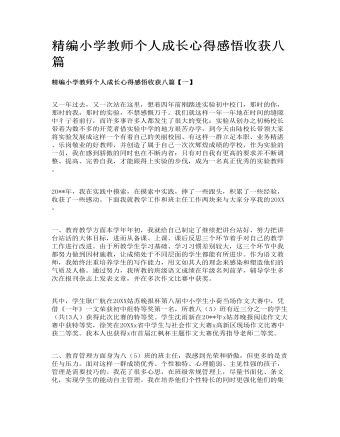
精编小学教师个人成长心得感悟收获八篇
一、教育教学方面本学年年初,我就给自己制定了继续把讲台站好、努力把讲台站活的大体目标,进而从备课、上课、课后反思三个环节着手对自己的教学工作进行改进。由于所教学生学习基础、学习习惯差别较大,这三个环节中我都努力做到因材施教,让成绩处于不同层面的学生都能有所进步。作为语文教师,我始终注重培养学生的写作能力,用文如其人的理念来感染和塑造他们的气质及人格。通过努力,我所教的班级语文成绩在年级名列前茅,辅导学生多次在报刊杂志上发表文章,并在多次作文比赛中获奖。
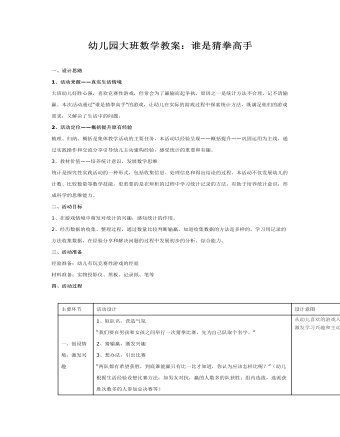
幼儿园大班数学教案:谁是猜拳高手
2、活动定位——概括提升原有经验梳理、归纳、概括是集体教学活动的主要任务,本活动以经验呈现——概括提升——巩固运用为主线,通过实践操作和交流分享引导幼儿主动建构经验,感受统计的重要和有趣。3、教材价值——培养统计意识,发展数学思维统计是探究性实践活动的一种形式,包括收集信息、处理信息和得出结论的过程。本活动不仅发展幼儿的计数、比较数量等数学技能,更重要的是在辩析的过程中学习统计记录的方法,有助于培养统计意识,形成科学的思维能力。二、活动目标1、在游戏情境中萌发对统计的兴趣,感知统计的作用。2、经历数据的收集、整理过程,通过数量比较判断输赢。知道收集数据的方法是多样的,学习用记录的方法收集数据,在经验分享和解决问题的过程中发展初步的分析、综合能力。三、活动准备经验准备:幼儿有玩竞赛性游戏的经验材料准备:实物投影仪、黑板、记录纸、笔等
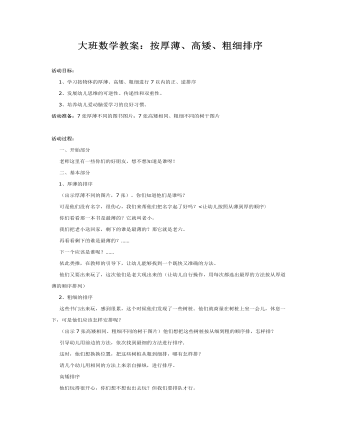
大班数学教案:按厚薄、高矮、粗细排序
2、发展幼儿思维的可逆性、传递性和双重性。 3、培养幼儿爱动脑爱学习的良好习惯。活动准备:7张厚薄不同的图书图片;7张高矮相同、粗细不同的树干图片 活动过程: 一、开始部分 老师这里有一些你们的好朋友,想不想知道是谁呀! 二、基本部分 1、厚薄的排序 (出示厚薄不同的图片,7张)。你们知道他们是谁吗? 可是他们没有名字,很伤心,我们来帮他们把名字起了好吗?<让幼儿按照从薄到厚的顺序〉
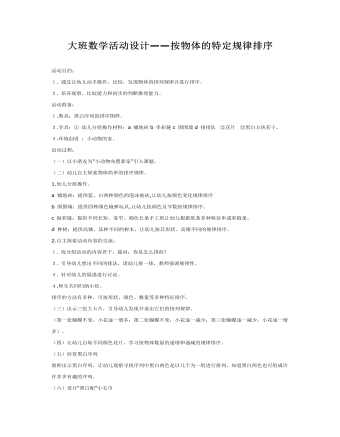
大班数学教案:按物体的特定规律排序
2. 培养观察、比较能力和初步的判断推理能力。活动准备: 1.教具:黑白序列的排序图样。2.学具:①幼儿分组操作材料:a 铺地砖b 串彩链c 围围墙d 排排队 ②花片 ③黑白方块若干。3.环境创设:小动物的家。活动过程:(一)以小朋友为“小动物布置新家”引入课题。(二)幼儿自主探索物体简单的排序规律。1.幼儿分组操作。a 铺地砖:提供蓝、白两种颜色的泡沫地砖,让幼儿按颜色变化规律排序 b 围围墙:提供四种颜色炮弹玩具,让幼儿按颜色及节数按规律排序。c 做彩链:提供不同长短、宽窄、颜色长条手工纸让幼儿根据纸条多种特征串成彩链条。d 种树:提供高矮、品种不同的树木,让幼儿按其形状、高矮不同的规律排序。
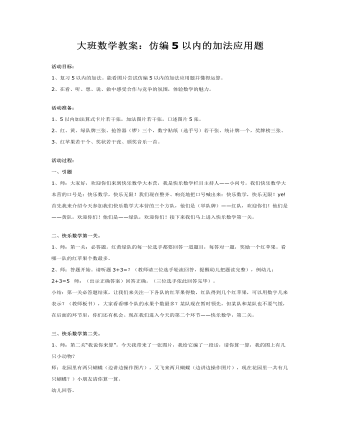
大班数学教案:仿编5以内的加法应用题
活动准备: 1、5以内加法算式卡片若干张,加法图片若干张,口述图片5张。 2、红、黄、绿队牌三张、抢答器(锣)三个,数字贴纸(选手号)若干张、统计牌一个,奖牌榜三张、 3、红苹果若干个、奖状若干张、颁奖音乐一首。 活动过程: 一、引题 1、师:大家好,欢迎你们来到快乐数学大本营,我是快乐数学栏目主持人——小问号。我们快乐数学大本营的口号是:快乐数学,快乐无限!我们现在整齐、响亮地把口号喊出来:快乐数学,快乐无限!ye! 首先我来介绍今天参加我们快乐数学大本营的三个方队,他们是(举队牌)——红队,欢迎你们!他们是——黄队,欢迎你们!他们是——绿队,欢迎你们!接下来我们马上进入快乐数学第一关。 二、快乐数学第一关。 1、师:第一关:必答题。红黄绿队的每一位选手都要回答一道题目,每答对一题,奖励一个红苹果。看哪一队的红苹果个数最多。 2、师:答题开始。请听题3+3=?(教师请三位选手轮流回答,提醒幼儿把题读完整),例幼儿:2+3=5 师:(出示正确答案)回答正确。(三位选手依此回答完毕)。

幼儿园大班数学教案:开心鸭子和松鼠
2、能仔细观察图片,能独立地找出不同的特征尝试进行分合。 3、乐于接受和尝试新的方法进行操作。 活动准备: 经验准备:幼儿已学习过7、8的组成。 物质准备: 教具:乌龟一家的图片(图上有7只乌龟,1只大乌龟,六只小乌龟,三只在岸上,四只在水里) 学具:《幼儿用书》(P7页)幼儿人手一支笔。 活动过程: ※乌龟一家出来玩 ——教师(出示一张“乌龟一家”的图片),今天天气真好啊,乌龟一家出来玩啦,看,这儿有几只乌龟?他们都一样吗?哪儿不一样啊? ——提醒幼儿先记录总数,再引导幼儿观察图上有的乌龟有什么相同与不同的地方。 ——教师:我们发现了许多不一样的地方,谁按这些不同把乌龟分成两组? ——幼儿思考并尝试将乌龟分成两组,说一说:大乌龟有几只,小乌龟有几只,根据大小特征,用分合式记录乌龟的数量。然后再找出一个不同点分一分并记录,如:按乌龟所在的位置不同,分为三只在岸上和四只在水里等。
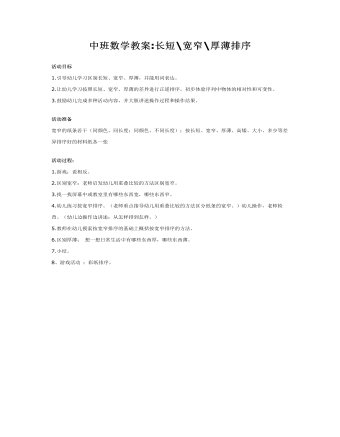
中班数学教案:长短宽窄厚薄排序
2.让幼儿学习按照长短、宽窄、厚薄的差异进行正逆排序,初步体验序列中物体的相对性和可变性。 3.鼓励幼儿完成多种活动内容,并大胆讲述操作过程和操作结果。活动准备 宽窄的纸条若干(同颜色、同长度;同颜色、不同长度);按长短、宽窄、厚薄、高矮、大小、多少等差异排序好的材料纸各一张
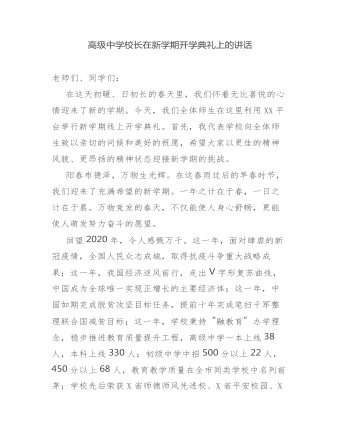
疫情后高级中学校长在新学期开学典礼上的讲话
回望2020年,令人感慨万千。这一年,面对肆虐的新冠疫情,全国人民众志成城,取得抗疫斗争重大战略成果;这一年,我国经济逆风前行,走出V字形复苏曲线,中国成为全球唯一实现正增长的主要经济体;这一年,中国如期完成脱贫攻坚目标任务,提前十年完成笔扫千军整理联合国减贫目标;这一年,学校秉持“融教育”办学理念,稳步推进教育质量提升工程,高级中学一本上线38人,本科上线330人;初级中学中招500分以上22人,450分以上68人,教育教学质量在全市同类学校中名列前茅;
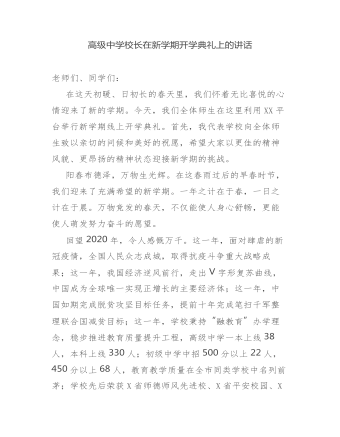
疫情后高级中学校长在新学期开学典礼上的讲话发言.
成绩属于过去,它更是鞭策我们前进的动力,逆水行舟,不进则退。新的学期,孕育着新的希望和憧憬,我们的每一位老师和同学,在经过一个寒假的短暂休息与调整之后,又将满怀信心、斗志昂扬地站在新学期的起跑线上,为实现理想目标而全身心投入工作和学习。


